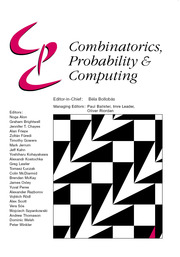Article contents
Planting Colourings Silently
Published online by Cambridge University Press: 07 December 2016
Abstract
Let k ⩾ 3 be a fixed integer and let Zk (G) be the number of k-colourings of the graph G. For certain values of the average degree, the random variable Zk (G(n, m)) is known to be concentrated in the sense that  $\tfrac{1}{n}(\ln Z_k(G(n,m))-\ln\Erw[Z_k(G(n,m))])$ converges to 0 in probability (Achlioptas and Coja-Oghlan, Proc. FOCS 2008). In the present paper we prove a significantly stronger concentration result. Namely, we show that for a wide range of average degrees,
$\tfrac{1}{n}(\ln Z_k(G(n,m))-\ln\Erw[Z_k(G(n,m))])$ converges to 0 in probability (Achlioptas and Coja-Oghlan, Proc. FOCS 2008). In the present paper we prove a significantly stronger concentration result. Namely, we show that for a wide range of average degrees,  $\tfrac{1}{\omega}(\ln Z_k(G(n,m))-\ln\Erw[Z_k(G(n,m))])$ converges to 0 in probability for any diverging function
$\tfrac{1}{\omega}(\ln Z_k(G(n,m))-\ln\Erw[Z_k(G(n,m))])$ converges to 0 in probability for any diverging function  $\omega=\omega(n)\ra\infty$ . For k exceeding a certain constant k 0 this result covers all average degrees up to the so-called condensation phase transitiond k,con , and this is best possible. As an application, we show that the experiment of choosing a k-colouring of the random graph G(n,m) uniformly at random is contiguous with respect to the so-called ‘planted model’.
$\omega=\omega(n)\ra\infty$ . For k exceeding a certain constant k 0 this result covers all average degrees up to the so-called condensation phase transitiond k,con , and this is best possible. As an application, we show that the experiment of choosing a k-colouring of the random graph G(n,m) uniformly at random is contiguous with respect to the so-called ‘planted model’.
MSC classification
Information
- Type
- Paper
- Information
- Copyright
- Copyright © Cambridge University Press 2016
References
- 11
- Cited by

